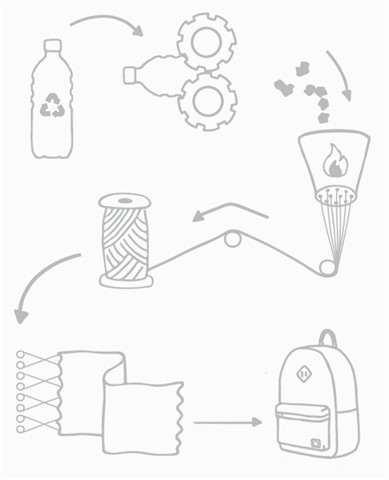What is recycled fabric?
Textiles made of natural or synthetic fibres are not just used for clothes but also used in homes, hospitals, workplaces, vehicles, in form of cleaning materials, as leisure equipment, or protective wear and so on. If these textiles are sorted, graded and reused again to make fabrics for different end uses it is called as recycled fabric.
Synthetic fibres i.e. man-made fibres like Polyester and Nylon are the most used and popular in the world. Polyester fibre demand in the world is much higher than any other natural or man made fibres since year 2002 and it will continue to grow at a significantly faster rate as calculated by England-based PCI Fibres in its forecast out to 2030.
Textiles made of regular polyester fibre are not environment friendly as the production of fabric involves huge quantities of water, chemicals and use of fossil fuels. The raw materials as well the byproducts are toxic, pollute water and air and cause several health issues. Hence companies have found ways to create polyester out of recycled plastic bottles or even recycled polyester fabric.
Similarly great progress has also been made to recycle other synthetic fibres types like nylon and spandex to make recycled fabrics to prevent fabric going to waste/landfill.
Use of recycled fabrics have significant importance as it provides both environmental and economic benefits.
What are they made from? And what variation do Recycled fabrics comes?
We consider recycled polyester fabrics as an example to know more about the process and methods used for recycling.
Recycled polyester fabric uses PET (polyethylene terephthalate) as raw material and this comes from recycled plastic bottles which goes to landfill. The Recycled polyester uses 33-53% less energy than regular polyester and it can be continuously recycled. Recycled polyester also doesn’t require huge land to grow a crop or use of gallons of water like cotton for its production.
Recycled polyester fabrics can also come from used polyester fabrics where the recycling process starts by cutting the polyester garments into small pieces. The shredded fabric is then granulated and turned into polyester chips. The chips are melted and spun into new filament fibers used to make new polyester fabrics.
The source of RPET (recycled polyethylene terephthalate) is divided into “post-consumer” RPET and “post-industrial RPET. A small percentage for source of RPET can also come from the by product from fiber and yarn manufacturer supplying to garment making or retail industry.
The post-consumer RPET comes from used bottles by people; post-industrial RPET is from unused packaging in manufacturing plants or by products of manufacturing.

How is it made?
1. Sort it.
Clear plastic PET bottles are collected and cleaned at the sorting facility.
2. Shred it.
Bottles are crushed into small plastic flakes
3. Melt it.
The plastic flakes are melted into small pellets
4. Spin it.
The pellets are melted again, then extruded and spun into thread.
5. Weave it.
The thread is woven into fabric and dyed.
6. Sew it.
Cutting, making and trimming of the final product.
These famous brands and their recycled product collection








The world’s leading brands are choosing recycled fabric to drive bags product innovation by combining uncompromising performance with trusted sustainability.
Contact us please if you need more details, our service includes below,
(1) Develop a new product collection for next year.
(2) Figure out the cost if your existing product changes to recycled fabric.
Post time: Jan-14-2021
